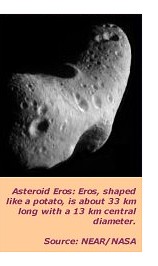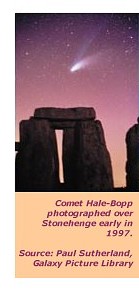| ����Task Force Report: Chapter 2 |
ASTERIODS,
COMETS AND
���������������NEAR-EARTH
OBJECTS
 Asteroids
are sometimes called minor planets. Like the Earth and all the planets,
asteroids move in orbits around the Sun, and so do comets. Asteroids and
comets are remnants of the formation of the Solar System about 4.5 billion
years ago. Asteroids were the building blocks of the inner planets; both
they and comets delivered to Earth life�s building blocks, carbon and
water. Asteroids and comets can range in size from pebbles or lumps of
ice, to rocky or icy worlds nearly 1,000 kilometres across.
Asteroids
are sometimes called minor planets. Like the Earth and all the planets,
asteroids move in orbits around the Sun, and so do comets. Asteroids and
comets are remnants of the formation of the Solar System about 4.5 billion
years ago. Asteroids were the building blocks of the inner planets; both
they and comets delivered to Earth life�s building blocks, carbon and
water. Asteroids and comets can range in size from pebbles or lumps of
ice, to rocky or icy worlds nearly 1,000 kilometres across.
There are countless numbers of asteroids and comets in the Solar System in well-defined regions far from the Earth.The gravitational forces of the large planets, mostly the huge planet Jupiter (which comprises about 90 per cent of the combined mass of all the planets), and collisions with other asteroids or comets, slowly alter the orbits of these small bodies.
Following many deflections, an asteroid or comet may occasionally become a Near Earth Object, when its orbit intersects that of the Earth or is within 0.3 Astronomical Units (astronomers call the Earth to Sun distance one �Astronomical Unit� or 1 AU). It may even crash onto the Earth. An object is said to be potentially hazardous when its orbit comes even closer to Earth, to within 0.05 AU (7.5 million kilometres or about 20 times the Earth to Moon distance) and when it is at least 150 metres in diameter. So far, 258 potentially hazardous objects have been discovered, a number that increases all the time as the surveys continue. Given enough accurate measurements of the position of an asteroid or comet, astronomers can predict their paths over centuries. But as they move about the Solar System, they continue to suffer small deflections so that their orbits are not wholly predictable far into the future.
Comets can sometimes be seen easily by the naked eye when they are near the Sun, by their bright tails. Asteroids are dark and generally smaller, and are invisible to the naked eye; this is why not even the biggest, Ceres (933 kilometres across), was discovered until 1801. Astronomers are finding that the distinction between comets and asteroids is becoming increasingly blurred; but it is still convenient to speak of them separately as we do below.
Asteroids
Most asteroids are in orbits between those of Mars and Jupiter, two to
four times further from the Sun than is the Earth (or 2 to 4 AU). This
main belt of asteroids contains about 1 million objects over 1 kilo-metre
in diameter.
Unlike stars, asteroids emit no visible light. We can only see them by the Sun�s reflected light using a powerful telescope; this is because each asteroid is very small and its surface so dark that small percentage of the light falling on it. Usually we see an asteroid only as a point source so that its size cannot be directly determined. It is therefore difficult to calculate the destructive power of an asteroid if it were to impact on the Earth.We discuss this problem further in Chapter 5.
Asteroids are made of carbonaceous (carbon containing) materials, rocks (silicates) or metal.They may comprise piles of boulders held together only by their own very weak gravitational attraction, or be solid lumps of stone or slabs of iron.They are not spherical and may spin or tumble as they go. Stony asteroids can have a density substantially less than that of the material of which they are made, indicating that they may sometimes be porous or loosely packed.There are many sub-categories of asteroids: each behaves differently when entering the Earth�s atmosphere, and in its reaction to countermeasures.
Comets
Many comets are in the Edgeworth-Kuiper Belt, a region beyond Neptune,
between 30 to 1,000 times further from the Sun than the Earth. Perturbations
of comets at the inner edge of the Belt by giant planets cause them to
evolve out of the Belt giving rise to so called short-period comets, with
periods of less than 200 years and orbits close to the plane in which
the planets move.
At the time of the formation of the giant planets, much of the small
icy debris from which they were forming was ejected from the Solar System
by the powerful gravitational forces of the growing planets. Some of these
small bodies were almost but not quite ejected and remain in very long
orbits, forming the so-called Oort cloud. The cloud comprises billions
of comets in a spherical shell around the outer reaches of the Solar System, about 40 to 50 thousand times further away from the Sun
than the Earth or about one light-year, a quarter of the way to our nearest
star. The Oort cloud is the source of long-period comets with return times
greater than 200 years.
Solar System, about 40 to 50 thousand times further away from the Sun
than the Earth or about one light-year, a quarter of the way to our nearest
star. The Oort cloud is the source of long-period comets with return times
greater than 200 years.
The regions from which comets come are so cold that they still contain frozen gases including water vapour, methane, ammonia, carbon dioxide and hydrogen cyanide. Comets are essentially �dirty snow-balls� and include many particles of dust. It is only when a comet comes near the Sun that these gases evaporate, freeing the dust that forms the tail sometimes seen by the naked eye. Using a powerful telescope, it is possible to observe the tails of many comets even at a distance of 5 AU from the Sun. However, some comets have lost their volatile gases and no longer generate tails; these dead comets look much like asteroids and can only be seen when near the Earth.
Short-period comets are likely to have been seen before and their orbits can be accurately measured; possible impacts can thus be predicted well in advance. Long-period comets have not been near the Earth during the brief age of science, so their orbits cannot have been determined and are therefore impossible to predict. Such comets may arrive from almost any direction.These factors make long-period comets particularly dangerous � the more so if they are dead and therefore difficult to observe. Even with very large special survey telescopes we could have less than a year�s warning of a possible impact (see Chapter 8).
A comet can be many times more damaging than an asteroid of the same mass.This is because comets on average have an impact speed about twice that of an asteroid, and their energy or destructive power goes as the square of their velocity.
Numbers
Estimates of the numbers of Near Earth Objects of different sizes can
be made either by direct measurement using ground-based telescopes or
by observing the numbers and sizes of craters on the Moon or on the planet
Mercury. The graph below shows the results of bringing together both these
methods of estimation, for asteroids only. Comets would increase the numbers
by only a few per cent. There are roughly 1,000 near Earth asteroids of
diameter greater than 1 kilometre, and about 100,000 with diameters greater
than 100 metres.
However, the numbers are very uncertain: for asteroids above 1 kilometre the correct number could be anywhere in the range 500 to 1,500, while for 100-metre asteroids the range is even wider � 30,000 to 300,000.These uncertainties underlie the need for more and better observations.
Chapter 3 - Environmental Effects on the Earth
Annex A, Annex B, Annex C, Annex D, Annex E, Annex F
Crown Copyright � 2000. All rights reserved.
Conditions of Use